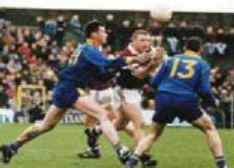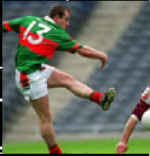Gaelic Football…basic rules and history
Gaelic Football can be described as a mixture
of soccer and rugby, although it predates both of those games. It is a
field game that has developed as a distinct game similar to the progression
of Australian Rules. Indeed it is thought that Australian Rules evolved
from Gaelic Football through the many thousands who were either deported
or emigrated to Australia from the middle of the twentieth century. Gaelic
Football is played on a pitch approximately 137m long and 82m wide. The
goalposts are the same shape as on a rugby pitch, with the crossbar lower
than a rugby one and slightly higher than a soccer one.  The
ball used in Gaelic Football is round, slightly smaller than a soccer
ball. It can be carried in the hand for a distance of four steps and can
be kicked or "hand-passed", a striking motion with the hand or fist. After
every four steps the ball must be either bounced or "solo-ed", an action
of dropping the ball onto the foot and kicking it back into the hand.
You may not bounce the ball twice in a row. To score, you put the ball
over the crossbar by foot or hand / fist for one point or under the crossbar
and into the net by foot or the hand / fist in certain circumstances for
a goal, the latter being the equivalent of three points. Each team consists
of fifteen players, lining out as follows: One goalkeeper, three full-backs,
three half-backs, two midfielders, three half-forwards and three full-forwards.
The actual line out on the playing field is as follows:
The
ball used in Gaelic Football is round, slightly smaller than a soccer
ball. It can be carried in the hand for a distance of four steps and can
be kicked or "hand-passed", a striking motion with the hand or fist. After
every four steps the ball must be either bounced or "solo-ed", an action
of dropping the ball onto the foot and kicking it back into the hand.
You may not bounce the ball twice in a row. To score, you put the ball
over the crossbar by foot or hand / fist for one point or under the crossbar
and into the net by foot or the hand / fist in certain circumstances for
a goal, the latter being the equivalent of three points. Each team consists
of fifteen players, lining out as follows: One goalkeeper, three full-backs,
three half-backs, two midfielders, three half-forwards and three full-forwards.
The actual line out on the playing field is as follows:
|
Goalkeeper
|
|||
|
Right corner-back
|
Full-back
|
Left corner-back | |
|
Right half-back
|
Centre half-back
|
Left half-back | |
|
Midfielder Midfielder
|
|||
|
Right half-forward
|
Centre half-forward
|
Left half-forward | |
|
Right corner-forward
|
Full-forward
|
Left corner-forward | |
Players wear a jersey with their team colours
and number on the back. Both teams must have different colour jerseys.
The goalkeepers' jerseys must not be similar to the jersey of any other
player. Referees normally tog out in black jerseys, socks and togs. Goalkeepers
may not be physically challenged whilst inside their own small parallelogram,
but players may harass them into playing a bad pass, or block an attempted
pass.  Teams
are allowed a maximum of five substitutes in a game. Players may switch
positions on the field of play as much as they wish but this is usually
on the instructions of team officials. Officials for a game comprise of
a referee, two linesmen (to indicate when the ball leaves the field of
play at the side and to mark '45'' free kicks and 4 umpires (to signal
scores, assist the referee in controlling the games, and to assist linesmen
in positioning '45' frees). Raising a green flag placed to the left of
the goal signals a goal. Raising a white flag placed to the right of goal
signals a point. A '45'/'65' is signalled by the umpire raising his/her
outside arm. A 'square ball', when a player scores having arrived in the
'square' prior to receiving the ball, is signalled by pointing at the
small parallelogram. There are many competitions run throughout the year.
Club competitions work on a basis of underage through to adult, with the
adults being divided into three levels Junior, Intermediate and Senior,
organised primarily on club size rather than ability. Any club can progress
through the different levels to compete at the highest level and become
the county Senior champions. Winners of a county championship can then
progress through to the provincial championships, with the four provincial
winners meeting annually on a knockout basis to compete for the honour
of being the National Club Champions in a final traditionally held at
Croke Park on St. Patrick's Day. The best players in each county are chosen
to compete in inter-county competitions. One of these is the National
League.
Teams
are allowed a maximum of five substitutes in a game. Players may switch
positions on the field of play as much as they wish but this is usually
on the instructions of team officials. Officials for a game comprise of
a referee, two linesmen (to indicate when the ball leaves the field of
play at the side and to mark '45'' free kicks and 4 umpires (to signal
scores, assist the referee in controlling the games, and to assist linesmen
in positioning '45' frees). Raising a green flag placed to the left of
the goal signals a goal. Raising a white flag placed to the right of goal
signals a point. A '45'/'65' is signalled by the umpire raising his/her
outside arm. A 'square ball', when a player scores having arrived in the
'square' prior to receiving the ball, is signalled by pointing at the
small parallelogram. There are many competitions run throughout the year.
Club competitions work on a basis of underage through to adult, with the
adults being divided into three levels Junior, Intermediate and Senior,
organised primarily on club size rather than ability. Any club can progress
through the different levels to compete at the highest level and become
the county Senior champions. Winners of a county championship can then
progress through to the provincial championships, with the four provincial
winners meeting annually on a knockout basis to compete for the honour
of being the National Club Champions in a final traditionally held at
Croke Park on St. Patrick's Day. The best players in each county are chosen
to compete in inter-county competitions. One of these is the National
League. Four divisions see the county teams compete on a league basis, the first
part being from October to the end of November, and then resuming in February
for completion of the programme. The top two teams from each of the premier
divisions then progress to semi-finals and final to determine the National
League champions However the main competition is The All-Ireland Championship.
The format is for each county to compete in their respective Provincial
championship, with the four winners eventually progressing to the All-Ireland
semi-finals, the victors then going on to compete for the Sam Maguire
trophy on the third weekend of September. This is a matter of huge prestige
to the counties involved, the matches always attracting huge crowds in
excess of 60, 000 supporters, as well as countless thousands watching
on TV around the world…about 200 or so here in Abu Dhabi. This match is
traditionally preceded by the Minor (U-18) final and is indeed one of
the great days in Irish sport.
Four divisions see the county teams compete on a league basis, the first
part being from October to the end of November, and then resuming in February
for completion of the programme. The top two teams from each of the premier
divisions then progress to semi-finals and final to determine the National
League champions However the main competition is The All-Ireland Championship.
The format is for each county to compete in their respective Provincial
championship, with the four winners eventually progressing to the All-Ireland
semi-finals, the victors then going on to compete for the Sam Maguire
trophy on the third weekend of September. This is a matter of huge prestige
to the counties involved, the matches always attracting huge crowds in
excess of 60, 000 supporters, as well as countless thousands watching
on TV around the world…about 200 or so here in Abu Dhabi. This match is
traditionally preceded by the Minor (U-18) final and is indeed one of
the great days in Irish sport.